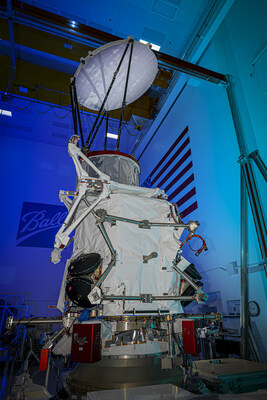Ball Aerospace Enters Final Stages of Building Space Force's Next-Gen Operational Weather Satellite
Ball Aerospace has successfully completed the spacecraft bus for the Weather System Follow-on-Microwave (WSF-M) satellite, a project for the U.S. Space Force. Final environmental testing on the Microwave Imager (MWI) instrument was also concluded, with subsequent steps including final vehicle assembly and integration underway. WSF-M aims to enhance environmental prediction capabilities for the Department of Defense, addressing critical gaps in monitoring ocean surface winds and space weather. Ball has also secured a contract modification to develop a second WSF-M vehicle, targeted for completion by late 2027.
- Completion of the WSF-M spacecraft bus enhances Ball's capabilities in spacecraft technology.
- Finalization of Microwave Imager testing supports the operational readiness of the satellite.
- Contract modification for a second WSF-M vehicle demonstrates ongoing demand and future revenue potential.
- None.
- Ball Aerospace completes satellite bus integration and microwave imager testing
BROOMFIELD, Colo., Jan. 10, 2023 /PRNewswire/ -- Ball Aerospace completed the spacecraft bus for the Weather System Follow-on-Microwave (WSF-M) satellite, the U.S. Space Force's next-generation operational environmental satellite system. Ball also finalized environmental testing on the Microwave Imager (MWI) instrument and has started final space vehicle assembly, integration and testing.
Upon delivery, WSF-M will provide mission data to Department of Defense's (DoD) environmental prediction systems that support all warfighter domains. In addition, it will broadcast real-time, actionable environmental intelligence to on-going military operations across the globe.
"The nearly simultaneous completion of the spacecraft bus and instrument testing mark a significant milestone for the WSF-M program," said, Hope Damphousse, vice president, Strategic Operations, Ball Aerospace. "We are moving forward with spacecraft integration of the MWI sensor, along with a government-furnished Energetic Charged Particle (ECP) sensor, which will be followed by a suite of space vehicle performance and environmental tests."
At the heart of the WSF-M payload is the Ball-built MWI sensor that takes calibrated passive radiometric measurements at multiple microwave frequencies to measure sea surface winds, tropical cyclone intensity and additional environmental data. The ECP sensor will provide critical space weather measurements. WSF-M was designed to mitigate three high-priority DoD Space-Based Environmental Monitoring (SBEM) gaps: ocean surface vector winds, tropical cyclone intensity and the space weather gap, low Earth orbit (LEO) energetic charged particles. It will also address three additional SBEM gaps: sea ice characterization, soil moisture and snow depth. Ball Aerospace was recently awarded the contract modification to develop and build the second WSF-M space vehicle, expected to be completed by late 2027.
Ball Aerospace has played key roles on numerous operational weather satellite programs. Its Ozone Mapping and Profiler Suite (OMPS) instruments are operating on the Ball-built Suomi NPP and NOAA-20 satellites, launched in 2011 and 2017, respectively. OMPS is also on board the Joint Polar Satellite System-2 (JPSS-2), which launched on November 10, 2022. Ball is on contract with NASA to build two additional OMPS instruments for JPSS-3 and JPSS-4. The Ball-built Ion Velocity Meter (IVM) space weather sensors are flying on five of the six Constellation Observing System for Meteorology, Ionosphere and Climate-2 (COSMIC-2) satellites, a joint program with the U.S. Air Force, U.S. Space Force, Taiwan's National Space Organization, NOAA and the University Corporation for Atmospheric Research that launched in 2019.
Powered by endlessly curious people with an unwavering mission focus, Ball Aerospace pioneers discoveries that enable our customers to perform beyond expectation and protect what matters most. We create innovative space solutions, enable more accurate weather forecasts, drive insightful observations of our planet, deliver actionable data and intelligence, and ensure those who defend our freedom go forward bravely and return home safely. Go Beyond with Ball.® For more information, visit www.ball.com/aerospace or connect with us on Facebook or Twitter.
About Ball Corporation
Ball Corporation (NYSE: BALL) supplies innovative, sustainable aluminum packaging solutions for beverage, personal care and household products customers, as well as aerospace and other technologies and services primarily for the U.S. government. Ball Corporation and its subsidiaries employ 24,300 people worldwide and reported 2021 net sales of
Forward-Looking Statements
This release contains "forward-looking" statements concerning future events and financial performance. Words such as "expects," "anticipates," "estimates," "believes," and similar expressions typically identify forward-looking statements, which are generally any statements other than statements of historical fact. Such statements are based on current expectations or views of the future and are subject to risks and uncertainties, which could cause actual results or events to differ materially from those expressed or implied. You should therefore not place undue reliance upon any forward-looking statements and they should be read in conjunction with, and qualified in their entirety by, the cautionary statements referenced below. Ball undertakes no obligation to publicly update or revise any forward-looking statements, whether as a result of new information, future events or otherwise. Key factors, risks and uncertainties that could cause actual outcomes and results to be different are summarized in filings with the Securities and Exchange Commission, including Exhibit 99 in Ball's Form 10-K, which are available on Ball's website and at www.sec.gov. Additional factors that might affect: a) Ball's packaging segments include product capacity, supply, and demand constraints and fluctuations and changes in consumption patterns; availability/cost of raw materials, equipment, and logistics; competitive packaging, pricing and substitution; changes in climate and weather; footprint adjustments and other manufacturing changes, including the startup of new facilities and lines; failure to achieve synergies, productivity improvements or cost reductions; unfavorable mandatory deposit or packaging laws; customer and supplier consolidation; power and supply chain interruptions; changes in major customer or supplier contracts or loss of a major customer or supplier; inability to pass through increased costs; war, political instability and sanctions, including relating to the situation in Russia and Ukraine and its impact on Ball's supply chain and its ability to operate in Europe, the Middle East and Africa regions generally; changes in foreign exchange or tax rates; and tariffs, trade actions, or other governmental actions, including business restrictions and shelter-in-place orders in any country or jurisdiction affecting goods produced by Ball or in its supply chain, including imported raw materials; b) Ball's aerospace segment include funding, authorization, availability and returns of government and commercial contracts; and delays, extensions and technical uncertainties affecting segment contracts; c) Ball as a whole include those listed above plus: the extent to which sustainability-related opportunities arise and can be capitalized upon; changes in senior management, succession, and the ability to attract and retain skilled labor; regulatory actions or issues including those related to tax, environmental, social and governance reporting, competition, environmental, health and workplace safety, including U.S. Federal Drug Administration and other actions or public concerns affecting products filled in Ball's containers, or chemicals or substances used in raw materials or in the manufacturing process; technological developments and innovations; the ability to manage cyber threats; litigation; strikes; disease; pandemic; labor cost changes; inflation; rates of return on assets of Ball's defined benefit retirement plans; pension changes; uncertainties surrounding geopolitical events and governmental policies, including policies, orders, and actions related to COVID-19; reduced cash flow; interest rates affecting Ball's debt; and successful or unsuccessful joint ventures, acquisitions and divestitures, and their effects on Ball's operating results and business generally.
![]() View original content to download multimedia:https://www.prnewswire.com/news-releases/ball-aerospace-enters-final-stages-of-building-space-forces-next-gen-operational-weather-satellite-301717693.html
View original content to download multimedia:https://www.prnewswire.com/news-releases/ball-aerospace-enters-final-stages-of-building-space-forces-next-gen-operational-weather-satellite-301717693.html
SOURCE Ball Aerospace
FAQ
What is the significance of the WSF-M satellite for the U.S. Space Force?
When is the second WSF-M space vehicle expected to be completed?
What are the key features of the Microwave Imager (MWI) instrument?
How does the WSF-M satellite address environmental monitoring gaps?









